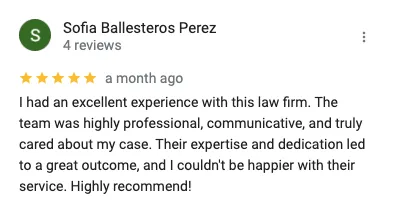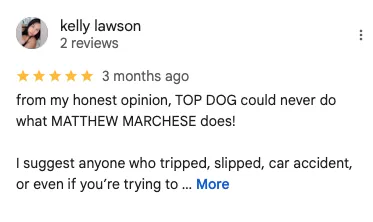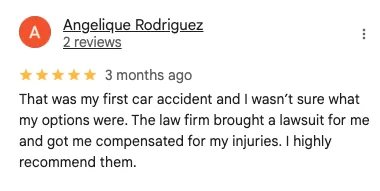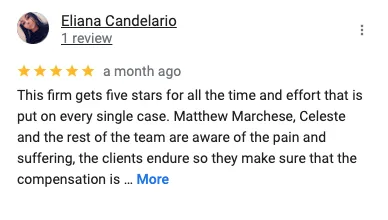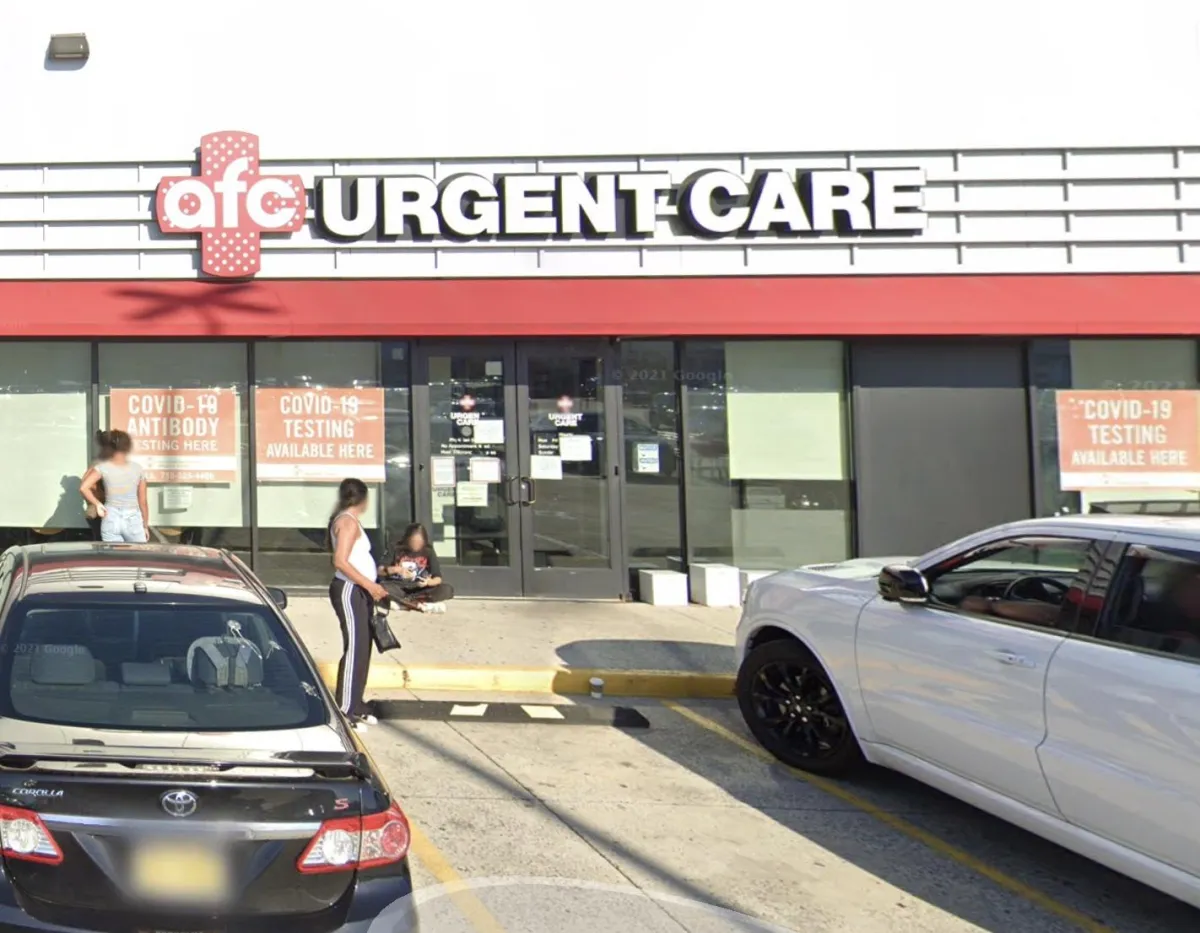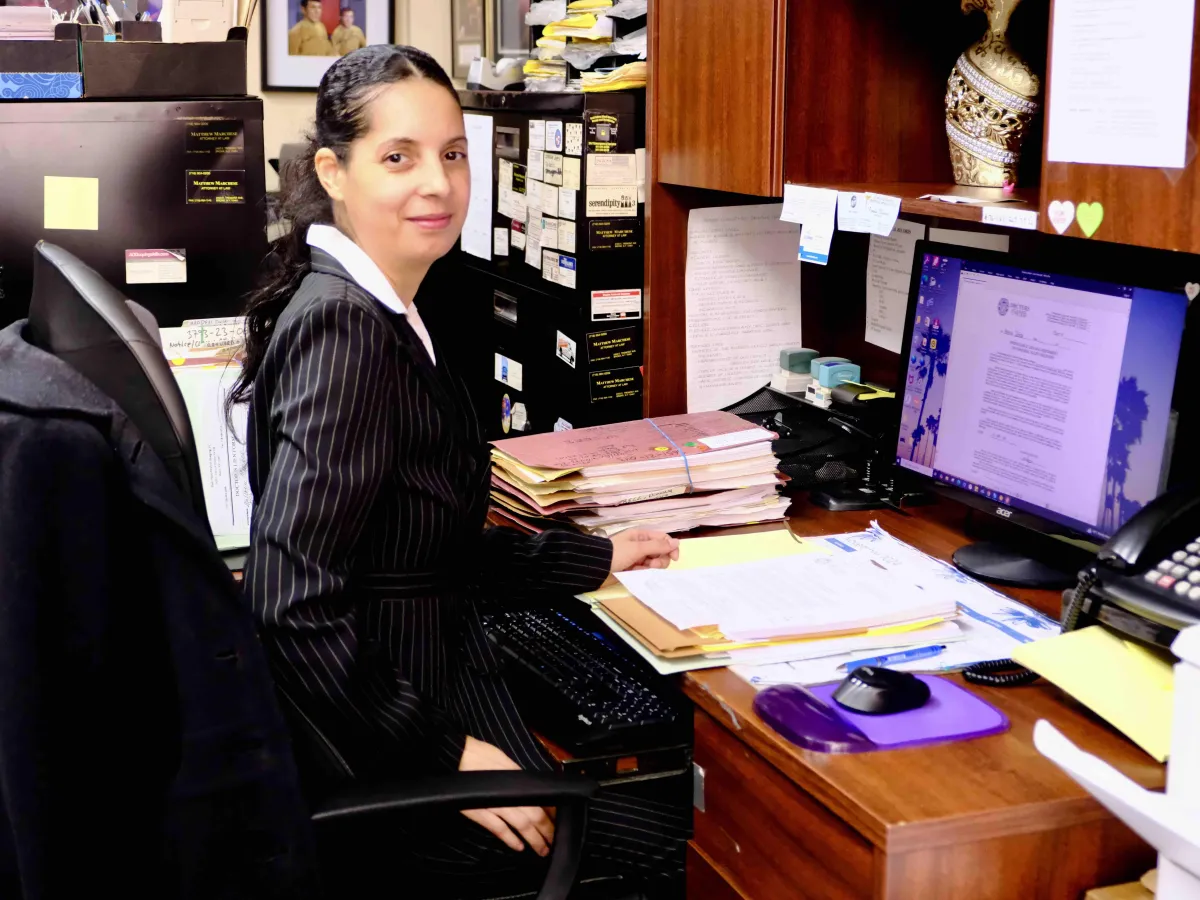I got checked out at Urgent Care after an accident. Do I have a case?
Don’t Stop at Urgent Care — It Hurts Your Case.
Insurance companies look for follow-up treatment. If you stop at urgent care, they argue your injuries weren’t serious.
Step 1: See a Specialist
Follow-up care with an orthopedist, neurologist, or physical therapist helps prove your injury is real and ongoing.
Step 2: Don’t Miss Appointments
Gaps in care are used against you. We help make sure treatment is consistent and properly documented.
Step 3: Let Us Guide the Process
We connect clients to doctors who understand both medical recovery and legal documentation — and who know how to protect your case.
Why Urgent Care Matters After an Accident
Many Bronx residents go to urgent care first — not the ER — after a crash or fall. It’s fast, local, and convenient. But what most people don’t realize is that your CityMD visit or similar clinic report becomes the first official medical record tied to your accident.
This early documentation can support future claims — even if you didn’t go by ambulance or report the injury right away. We often see clients visit urgent care a day or two later, then follow up with physical therapy or imaging after the pain sets in.
Clinics like Montefiore Urgent Care and local CityMDs are a common first step in Bronx accident cases. What matters most is what you do next — and how clearly your care is documented.
Video: What to Do After an Urgent Care Visit in the Bronx.
Steve, a team member here at MyBronxLawyer, explains what steps to take after an Urgent Care visit in the Bronx — and why acting fast makes all the difference.
I went to Urgent Care after an accident-is that enough?
No problem, we take cases all the time from clients who have treated at urgent Care.
If you went to urgent care after a car accident, fall, or other injury — you’re not alone. Many Bronx residents do the same because it’s faster and easier than the ER. But now the pain hasn’t gone away, and you’re wondering: do I have a case? Did I do enough? Will urgent care visits be taken seriously by insurance companies?
This page answers the questions most people ask after they’ve left urgent care and are thinking about their legal options. Whether you went to CityMD, Montefiore, or another local clinic — what you do next matters.
Legal Reality Check
What Insurance Companies Think About Urgent Care Treatment
Urgent care centers are convenient — but insurance adjusters may treat your visit as less “serious” than a trip to the ER. They look for reasons to downplay your pain, and starting with urgent care can be used against you if you don’t follow up properly.
The visit alone is not enough. Insurance companies want to see consistent treatment, referrals to specialists, and medical documentation that shows your injuries required ongoing care. If your pain got worse after urgent care and you didn’t go back — they’ll say you weren’t really hurt.
That’s why we step in early — to protect your rights, help secure your records, and make sure the insurance company doesn’t control the story. Even a basic urgent care visit can become strong evidence — if it’s handled the right way from the start.
Video: What to Do After an Urgent Care Visit in the Bronx.
Steve, a team member here at MyBronxLawyer, explains what steps to take after an Urgent Care visit in the Bronx — and why acting fast makes all the difference.
We specialize in Bronx accident victims who went to walk-in Urgent Care type facilities rather than a hospital. We’ve worked with clients who were seen at:
- CityMD South Bronx – 2902 3rd Ave, Bronx, NY 10455
- CityMD Mott Haven – 571 E 138th St, Bronx, NY 10454
- CityMD Soundview – 1613 Westchester Ave, Bronx, NY 10472
- CityMD Mt Eden – 48 E 170th St, Bronx, NY 10452
- CityMD Fordham – 388 E Fordham Rd, Bronx, NY 10458
- CityMD Southern Boulevard – 1047 Southern Blvd, Bronx, NY 10459
- CityMD Co-op City-Baychester – 2146 Bartow Ave, Bronx NY 10475
- CityMD Westchester Square – 32 Westchester Sq, Bronx, NY 10461
- CityMD Riverdale – 193 W 237th St, Bronx, NY 10463
- CityMD Norwood – 3494 Jerome Ave, Bronx, NY 10467
- Bronx Urgent Care P.C. – 1733 E 174th ST, Bronx, NY 10472
- +MEDRITE Urgent Care – 383 E 149th St, Bronx, NY 10451
- RH Medical Urgent Care – 3750B 3rd Ave, Bronx, NY 10456
- ModernMD/SBH Urgent Care – 4507 3rd Ave, Bronx, NY 10457
- MyDoc Urgent Care – 2826 Westchester Ave, Bronx, NY 10461
- Optum Urgent Care – Morris Park - 1049 Morris Park Ave, Bronx, NY 10461
- AFC Urgent Care – Throgs Neck-843 Hutchinson River Pkwy, Bronx, NY 10465
- AFC Urgent Care – Webster Ave-1210 Webster Ave, Bronx, NY 10456
- Centers Urgent Care – Hunts Point - 925 Hunts Point Ave, Bronx, NY 10474
- Union Community Health Center – 260 E 188th St, Bronx, NY 10458
- Montefiore Urgent Care – 2300 Westchester Ave, Bronx, NY
- BronxCare – 1650 Grand Concourse, Bronx, NY 10457
- BronxCare – 1276 Fulton Ave, Bronx, NY 10457
- Omega Health Urgent Care – 1 W Burnside Ave, Bronx, NY 10453
- Essen Urgent Care – 3991 White Plains Rd, Bronx, NY
- Essen Urgent Care – 1990 McGraw Ave, Bronx, NY
- Essen Urgent Care -1434 Williamsbridge Rd, Bronx, NY
- Essen Urgent Care – 2202 Grand Concourse, Bronx, NY
- Essen Urgent Care – 1550 University Ave, Bronx, NY
- Essen Urgent Care – 5665 Riverdale Ave, Bronx, NY
- Essen Urgent Care – 616 Castle Hill Ave, Bronx, NY
- Essen Urgent Care – 828 E 149th St, Bronx, NY
Treated at Urgent Care After an Accident or Injury?
We specialize in Bronx accident victims who went to walk-in Urgent Care type facilities rather than a hospital. We’ve worked with clients who were seen at:
|
|
Wondering What Your Case Might Be Worth? Start Here.
Steve, a team member at MyBronxLawyer, breaks down what goes into valuing a personal injury case in New York City — and what to expect if you’re wondering how much your case is worth.
- Your case value depends on your injury, treatment, and impact on daily life.
- We’ve won cases even when other firms said the case wasn’t worth much.
- Early steps matter — documentation, follow-up care, and strategy.
FAQ
How much is my case worth?
There’s no set number — but the right steps early on can make a big difference. We look at injury type, long-term effects, and who was at fault.
“I thought my case was too small — the first lawyer told me it wasn’t worth it. Matt got it settled for more than I ever expected.” — A.D., Bronx
We handle everything from medical records to final settlement.
- We gather your treatment records and injury documentation.
- We explain how case value is calculated — no legal jargon.
- We fight to maximize your recovery — not settle for less.
Timeline of a Typical Case After an Urgent Care Visit
You go to urgent care after a crash, fall, or other injury. You’re hoping the pain goes away.
Pain doesn’t improve — or it spreads. You realize it may be more serious than you thought.
You call a lawyer. We gather records, contact insurance, and help direct follow-up care.
You're referred for treatment: MRI, orthopedist, chiropractor, neurologist, or physical therapy.
Your records, bills, and pain journal start building real case value. Your case becomes documented, credible, and backed by care.
We negotiate your case. Depending on the facts, you may reach a settlement — or we may file suit to get the full value.
Common Injuries We See After Urgent Care Visits
Most Bronx accident victims start with a quick urgent care visit — but the real symptoms often show up later. Below are common injuries diagnosed after an initial walk-in appointment.
- Whiplash or neck strain: Usually shows up the day after a rear-end crash or fall. Often missed at first visit.
- Back injuries: Includes herniated discs or muscle sprain. Pain may worsen after the urgent care visit.
- Joint or ligament tears: Knee, shoulder, or wrist injuries that don’t fully appear on urgent care X-rays.
- Concussion or head trauma: May be documented as “headache” at urgent care — but develops into fogginess or nausea later.
- Soft tissue injuries: Bruising, swelling, and soreness that develop over time, especially in older patients.
If your pain worsened after the initial urgent care visit, follow-up care and clear notes help build your case. Keep all records — even if your injury seemed “minor” at first.
Why Urgent Care Records Matter
If you went to urgent care after an accident, your visit created a timestamped medical record — one of the most important parts of any injury claim. Even if no lawsuit is filed, these records help show:
- That you sought treatment quickly – delays can be used against you by insurance companies.
- That your pain was real from the start – even if symptoms got worse later.
- That a licensed provider made notes – such as injury location, movement limits, or need for imaging.
- That you followed medical advice – like going for follow-up or staying off work.
A single urgent care note — even one paragraph long — is better than nothing. Bring a copy to your follow-up or legal consultation if possible.
How to Get Your Urgent Care Records (and Why It Matters)
Your records are the first proof of pain. They show what hurt, when it hurt, and what the doctors saw. Even a short urgent care visit can contain key legal info.
Most urgent care centers — like CityMD, Montefiore, and AFC — will release records within 1–2 business days if requested. You don’t need them before calling us, but if you already have them, it helps us move faster.
We can request everything for you. But if you have a visit summary, discharge notes, or even a patient portal login — send it. It speeds up your case and strengthens your proof.
What If You Didn’t Go Right Away?
Many people don’t realize how hurt they are until hours or days later. If you waited to go to urgent care, that doesn’t automatically weaken your case — but timing should be addressed properly.
- Explain why you delayed care – pain setting in overnight or waiting to see if it improved is common.
- Be consistent about when symptoms began – this helps connect the injury to the accident.
- Document the visit clearly – ask the provider to include a note tying symptoms to the date of injury.
Late care is still valid care — especially if you now have a diagnosis, imaging, or doctor-recommended restrictions.
What If It’s Been More Than 72 Hours?
Delays happen — but that doesn’t mean your case is over. If it’s been a few days and you’re just now feeling the pain, start here.
View the 72-Hour GuideWhat If I Only Went to Urgent Care?
Many Bronx residents don’t go to the ER — they go to urgent care, then head home. That doesn’t disqualify you. But it does mean your documentation matters more.
- Yes, you can still file a claim: Most people start with urgent care because it’s faster and closer. As long as the records exist, your case is still valid.
- The type of care matters: Diagnoses, prescriptions, X-rays, and follow-up instructions all help build a timeline — even if you didn’t get an MRI yet.
- Act sooner rather than later: Insurance companies track delays. The longer you wait after urgent care to follow up, the more they’ll argue your injuries weren’t serious.
- Don’t throw anything out: Keep discharge paperwork, receipts, and prescriptions. These are often the only early proof a case happened at all.
If you went to urgent care within a few days of your accident, that record could be the key to getting your case taken seriously. It’s not too late to move forward.
What to Do After Going to Urgent Care for an Accident
If you went to urgent care after an accident — and not the ER — you're not alone. These steps can help you protect your rights and strengthen your case.
- Keep all paperwork from urgent care. Discharge forms, prescriptions, X-rays, and visit summaries prove you took the injury seriously and sought treatment quickly.
- Take photos of visible injuries. Document bruising, swelling, cuts, or scrapes — even minor ones. Photos from the first few days matter most.
- Make a timeline of what happened. Write down the location, how the accident occurred, and when symptoms started. Include dates of all medical visits.
- Schedule follow-up care. Go to your primary doctor, get referred to a specialist, or return to urgent care. Continued care shows that your injuries didn’t go away after one visit.
- Save receipts and reports. Transportation costs, medication receipts, and urgent care bills may all support your claim later on.
- Report the incident if you haven’t yet. Whether it happened in a store, on the street, or in a building, report it to management, the NYPD, or NYC 311 as needed.
Going to urgent care instead of the ER doesn’t hurt your case — but you still need to document everything properly. These steps give you a strong foundation.
Helpful Resources After an Accident in the Bronx
If you were in an Uber accident, slipped in a store or were injured in any type of accident, these NYC tools and local resources from our firm can help you take the next steps.
-
📄
How to Get Your NYPD Crash Report
Step-by-step guide to getting your police report after an Uber crash — online, at the precinct, or via insurance. -
🚘
2025 Bronx Uber Accident Strategy Guide
Real steps for Bronx riders and drivers: medical care, insurance claims, and what to expect in an Uber-related case. -
🇪🇸
Ayuda Legal en Español
Si habla español, esta página ofrece los recursos esenciales después de un accidente — todo explicado claramente. -
🛣️
Bronx Highway Accident Guide (2025)
If your Uber crash happened on the Cross Bronx, Deegan, or I-95, this guide explains how we build strong highway claims. -
❓
Uber Crash FAQs – Legal Help
Who’s at fault? Will insurance cover you? These real-world answers help you make smart choices after an accident.
Real Stories from Bronx Urgent Care Patients
These are real examples of accident victims who went straight to urgent care — and later realized how important those visits became.
- Slip and fall at a Bronx grocery store: A shopper fell on spilled liquid in an aisle. They walked to urgent care later that evening, where X-rays showed a wrist fracture.
- Rear-end car accident on the Bruckner: A driver was hit in stop-and-go traffic. No ambulance came. The next day, they went to urgent care for neck and shoulder stiffness — the first medical record tied to the crash.
- Pedestrian accident near Fordham Rd: A woman tripped on a broken sidewalk and went to CityMD for knee swelling. Her urgent care visit helped document pain that worsened over time.
- Work-related fall with delayed pain: A construction worker fell from a short ladder but didn't feel pain until the next morning. Urgent care documented lower back strain and referred him for further evaluation.
- Bike crash with no ER visit: A cyclist was clipped by a car mirror and thrown from their bike. Instead of calling 911, they walked into urgent care with bruised ribs and shoulder pain — the visit later became key to their case.
Urgent care visits are often the first — and sometimes only — record of what happened. Don’t throw out paperwork or wait too long to write down the details.
Real Bronx Results — No Hype, Just Proof.
We don’t just talk — we deliver. See what happened when Bronx clients put their accident cases in our hands.
Bronx Urgent Care Case Results
These clients didn’t take an ambulance or go straight to the ER — but they went to urgent care within days of their accident, and still got results.
Client fell on a wet floor outside urgent care after a separate store fall the day before. Their visit helped document the timeline of injury.
A Bronx client went to CityMD the day after a fender bender. Despite no ambulance, the record supported their spinal injury case.
Client slipped outside a deli and felt pain the next morning. They went to urgent care two days later and still had a successful claim.
No 911 call was made, but the client went to an urgent care within 48 hours. Imaging confirmed a fractured ankle and resulted in compensation.
These examples are based on real Bronx cases involving urgent care visits. Every case is different — but early documentation still matters, even if you didn’t go to the hospital right away.
Urgent Care Injury FAQ – Bronx Accidents
These are common questions from Bronx residents who went to urgent care after a fall, car accident, or workplace injury — and want to know what comes next.
Is going to urgent care enough to start a case?
Yes — if your visit was close in time to the accident and the paperwork documents your injuries. Make sure to keep your discharge papers, visit summary, and any imaging referrals you received.
What if I didn’t go the same day?
Delayed pain is common. If you went to urgent care a day or two later, that’s still helpful. Just be sure the visit notes link your symptoms to the accident and not a separate issue.
Will urgent care send my records anywhere?
No — you’re responsible for obtaining copies. Most Bronx urgent care centers will release your records if you ask, or let you log into a patient portal to download them. These are important for your file.
Should I follow up with another doctor?
Yes — urgent care usually handles basic evaluations and then refers out for ongoing care. Follow those instructions and keep records of any physical therapy, imaging, or specialists you see afterward.
What if urgent care didn’t give me anything?
If they didn’t give you paperwork, call them and ask for a copy of your visit summary or X-ray report. Even brief records can support your injury claim later.
Step two (Optional) - send photos of car damage, broken sidewalk, cuts, etc
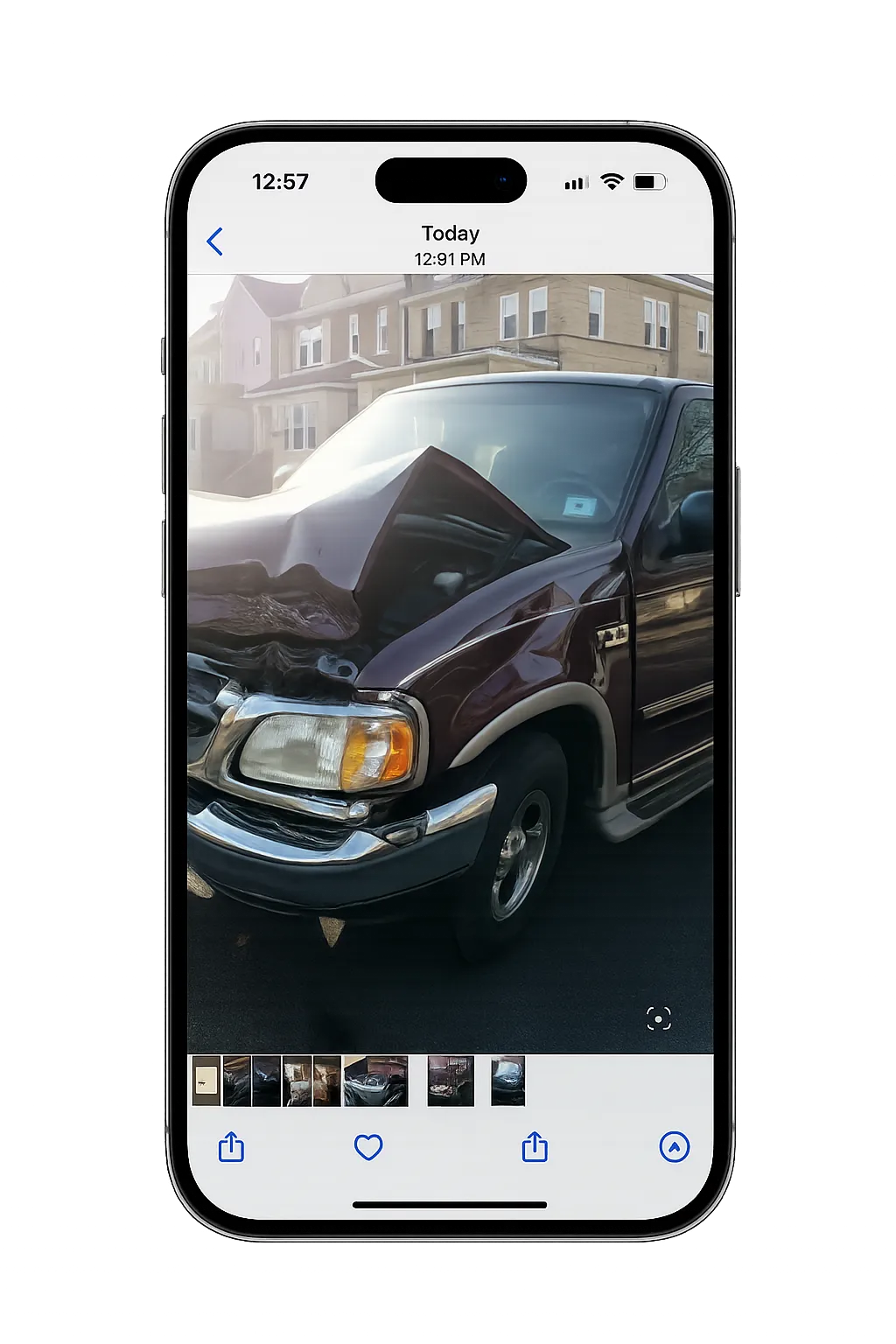
🔵 STEP 1. You send us your photos:
Accident damage, hospital bills, the scene-whatever you have. Text it.
We'll take it from there.

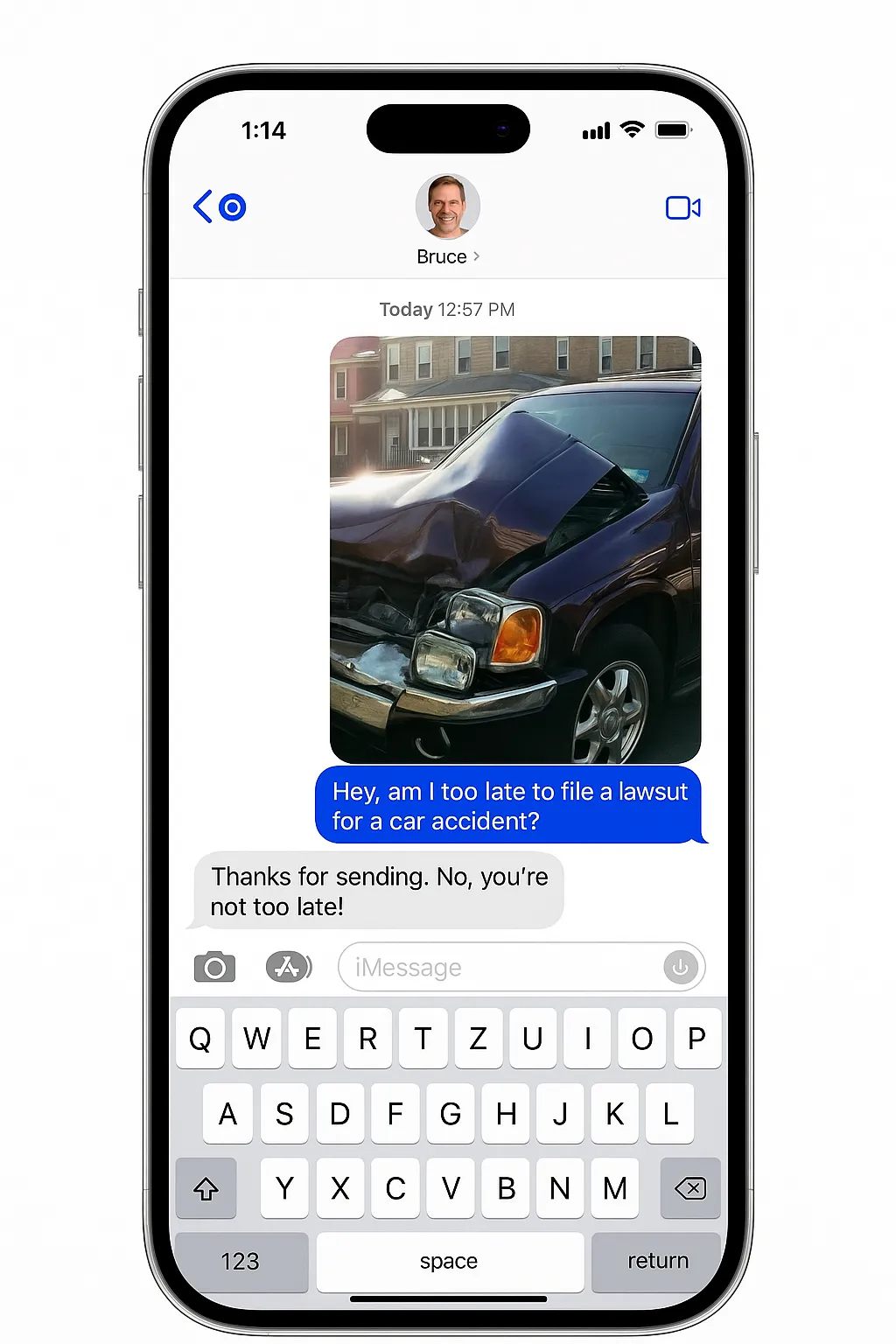
🟡 STEP 2. We review your photos right away:
No waiting. We look at your photos and reply quickly.


🔴 STEP 3. You get a text from us.
You'll know where you stand fast. And you'll receive a text from us, not a chatbot.
Urgent Care After Accident-What You Need to Know Guide (2025 Update)
This is your complete guide to urgent care visits after an accident in New York City. If you're looking for specifics like how it affects your injury claim, whether insurance will cover it, or what to do if you waited too long...more
Urgent Care
July 12, 2025 · 4 min read
Not everyone goes to the emergency room after an accident — especially if pain starts out mild. Urgent care is faster, closer, and usually less intimidating. But many clients worry: will insurance companies see it as “serious enough”?
The truth: both are valid. What matters more is whether your injury is **documented early**, and whether you **follow up**. If you stop after urgent care, the insurer may argue that you weren’t really injured — even if the pain got worse later.
Whether you went to urgent care or the ER, what matters now is what you do next. You need a lawyer who knows how to build a case from your first treatment — no matter where it was.
Hospital vs. Clinic
ER vs. Urgent Care — Does It Matter?
Call 7 days a week 9am-9pm.
LET'S TALK
VISIT US
© 2025 Matthew Marchese P.C. All Rights Reserved
Law Firm of Matthew Marchese, 2403 East Tremont Avenue, Bronx, NY, 10461
The information on this website is for general information purposes only. Nothing on this site should be construed as legal advice in any particular case. The information does not create an attorney-client relationship. Attorney advertising. Prior results do not guarantee a similar outcome.
How to Get Your Urgent Care Records (and Why They Matter)
Do I need my urgent care records before calling a lawyer?
No. We can get your records for you. But if you already have a visit summary, diagnosis sheet, or discharge paper — it helps us act faster. Even a photo of the documents is a great start.
How do I get my records if I went to CityMD or Montefiore?
Most urgent care centers use online portals or fax-based release forms. CityMD, Montefiore, and similar clinics can usually send records within 3–5 business days. We already know the process and can help request them.
What’s in the records that helps my case?
Doctors note your pain level, symptoms, tests ordered, diagnosis, and any recommendations. These details are often timestamped within 24–48 hours of the accident — which becomes powerful evidence when insurance companies try to question your injuries.
Don’t Stop at Urgent Care — It Hurts Your Case.
Insurance companies look for follow-up treatment. If you stop at urgent care, they argue your injuries weren’t serious.
Step 1: Get Evaluated by a Specialist
Follow-up care with an orthopedist, neurologist, or physical therapist helps prove your injury is real and ongoing.
Step 2: Don’t Skip Appointments
Missed visits and treatment gaps are used against you. We help keep your case on track and documented properly.
Step 3: Work With a Lawyer Who Knows the System
We connect you to trusted doctors who understand how to document your case correctly — and get results.
Timeline of a Typical Case After an Urgent Care Visit
Common Mistakes We See After Urgent Care Visits
or not clearly saying how the injury happened
because it “felt minor” at the time
especially after the initial visit
like ortho, neuro, or PT — weakens the case
even though they prove what happened
even when you're still in pain weeks later
8 Things To Do After an Urgent Care Visit
Going to urgent care was a smart first step. But what you do next matters — especially if you're still in pain, unsure about your case, or haven’t followed up yet.
↗️ See all 8 stepsKeep discharge papers or notes from the visit — they help prove when and where you got checked.
Pain often spreads or worsens after urgent care. Write down where it hurts now — even if it wasn’t mentioned before.
If you were told to follow up with a specialist, do it. Gaps in care hurt your case.
We can request your records from CityMD, AFC, Montefiore, and others — fast. If you already have them, that’s even better.
When the Big Firm Says No, Matt Says Yes.
Over 7,500 Bronx Cases Won. Real Clients. Real Results.
“We don’t judge how an accident happened — we step in when you need help the most. Whether it’s a car crash, a fall, or a hit while walking — our job is simple: to get justice for Bronx clients who were told they didn’t have a case. We take what others walk away from.”
— Matt, Lead Attorney

Learn More
Went to Urgent Care after an accident and not sure what comes next?
We've broken down what Bronx residents ask us most. In plain English.
Is urgent care enough to start a personal injury claim?
Yes — but it depends on what happened next. If you followed up with specialists, reported your pain clearly, and documented your visits, urgent care is often the first valid medical proof.
Can I still call a lawyer if I only went to urgent care?
Absolutely. Many clients don’t realize they have a case until pain continues. We’ve handled successful cases where urgent care was the first and only visit — until the right legal help stepped in.
What if I never went to the ER?
That’s fine. ER visits look more serious on paper, but urgent care is valid and admissible — especially if the injury worsened over time. Documentation and follow-up are what matter most.
Should I get my urgent care records before calling?
You can — but you don’t have to. If you have a visit summary or discharge notes, we’ll use them. If not, we know how to request them from CityMD, Montefiore, AFC, and others across the Bronx.
What if I didn’t mention all my pain?
It’s common. Many people don’t feel neck or back pain until hours — or days — later. That doesn’t disqualify you. The key is documenting it now and avoiding further gaps in care.
What kind of follow-up care should I get?
Orthopedic, neurologic, and physical therapy care are most common. We help connect clients to trusted doctors who understand injury cases and know how to write strong reports.
What if I threw away the paperwork?
We can still help. Most urgent care centers keep electronic records. As long as you know the location and approximate date, we’ll request what’s needed to support your claim.
How soon should I call a lawyer after urgent care?
Ideally within a few days. If your pain hasn’t improved, it’s time to act. We’ll step in, review what happened, and help guide the next move before you lose momentum.
FAQ
Get answers to commonly asked questions about urgent care visits after an accident — especially when you're unsure what to do next or if you still have a case.
Is going to urgent care enough to prove I was hurt?
Yes — but you must describe your pain clearly and follow any instructions. Insurance companies accept urgent care visits if they’re well documented and part of a bigger treatment plan.
Can I still have a case if I never followed up after urgent care?
Yes, but it’s harder. We help reopen the timeline and explain gaps. The sooner you get back into treatment, the stronger your claim becomes — especially for pain that never went away.
What if urgent care didn’t mention my neck or back pain?
That’s common. You may not have felt everything yet. We can still build your case — but it’s critical to document your pain now and begin follow-up care with the right providers.
Do I need to go back to urgent care if I’m still in pain?
No — but you should get seen again quickly. We can help you set up care with specialists who understand injury cases. The worst thing you can do is wait and hope it goes away.
What documents should I save from urgent care?
Save the visit summary, discharge notes, and any follow-up referrals. Even appointment confirmations or patient portal screenshots help us verify your treatment and injury date.
How do I get a copy of my urgent care records?
We’ll request them for you — fast. But if you have a patient portal, you can usually download a PDF or print a visit summary. Places like CityMD and AFC release records in 1–2 days.
Will insurance take my urgent care visit seriously?
Only if your story is consistent and you follow up. Insurers downplay urgent care if you stop treatment. We help show that your pain started at urgent care — and never stopped.
What if I told urgent care it “wasn’t an accident”?
This happens often. People downplay injuries or forget to explain how it happened. We help fix unclear charts and submit statements showing the true cause and timeline of your pain.
Do I need a lawyer if I only went to urgent care?
Yes — especially if pain got worse later. A lawyer can help prove that the injury started there, even if urgent care seemed minor. We turn early records into strong legal claims.
Learn More
Explore specific legal issues tied to real Bronx neighborhoods and crash types. These resources help explain what to expect if you were injured in one of these common local scenarios.
Helpful Info
What Should You Do
After Visiting Urgent Care?
If you’ve been to urgent care after a car accident or fall, you’re not alone — it’s one of the most common first steps. But urgent care notes alone aren’t always enough. Here’s what matters next, and how to protect your health and case.
Learn more ↗Urgent Care After Accident-What You Need to Know Guide (2025 Update)
This is your complete guide to urgent care visits after an accident in New York City. If you're looking for specifics like how it affects your injury claim, whether insurance will cover it, or what to do if you waited too long...more
Urgent Care
July 12, 2025 · 4 min read
ABOUT US
We truly believe in putting our clients first. We are part of the community we serve and we understand the challenges and needs of our clients better than any other law firm.
GET IN TOUCH
Mon - Fri | 9:00 AM - 5:00 PM
Sat - Sun | Closed
We answer the phone between 9am-9pm
QUICK LINKS
© 2025 Matthew Marchese P.C. All Rights Reserved
Law Firm of Matthew Marchese, 2403 East Tremont Avenue, Bronx, NY, 10461
The information on this website is for general information purposes only. Nothing on this site should be construed as legal advice in any particular case. The information does not create an attorney-client relationship. Attorney advertising. Prior results do not guarantee a similar outcome.

